The extraordinary of e-commerce: Why does delivery from China to Vietnam only take a few days, but the shipping fee is 10,000 VND – cheaper than the whole city?
- Tram Ho
According to Finance China, in the first nine months of 2022, 80 billion parcels were delivered in and out of China. That means on average, one in five Chinese is sending or receiving a parcel every day.
On shopping platforms like Taobao, Shopee or Lazada, the time to deliver a parcel only lasts from one to five days. The shipping fee is extremely affordable, prices from 3 Yuan (about 10,000 VND at this time) are also available.
Why can China’s e-commerce and shipping world do these things?
Mass customization promotes air freight instead of sea
Previously, the international e-commerce supply chain often went like this: first, goods with many different models and types would be collected and transported by sea to the destination country in one big trip. After arriving at the port, goods are classified and transported through many more stages before reaching consumers.
Great advances in digital technology allow merchants to mass customize their products, thereby gradually changing the above shipping model.
A prime example is fast fashion: Chinese fashion e-commerce retailer SHEIN was able, thanks to big data, to inform the mass production of fashion clothing at extremely low prices on a moderate scale. These clothing models are marketed to the right target groups, to specific customer groups in a specific geographical area. When customers choose a product, they feel like it’s ‘exclusive’ for them, even though it’s actually designed for a wider audience.

Image: SHEIN
As a result, sales to a group of customers in a particular region increase. SHEIN can ship these mass customization orders directly from the supplier directly to the destination by air. The local mail company will deliver the last mile to consumers faster because orders are concentrated in one area.
The fast turnaround time means that companies like Wish, Lazada and Shopee are also actively adopting this direct shipping model. From 2016 to 2020, the demand for direct shipping by Chinese companies has increased by 84%.
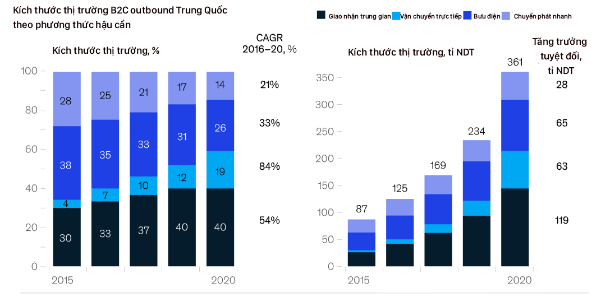
China outbound B2C market size by method of logistics. Source: McKinsey
How to ‘save’ sellers on e-commerce platforms
Today’s familiar platforms such as Taobao, Shopee are all “big guys” in the Chinese e-commerce industry. Therefore, these stores all enjoy great discounts from shipping companies, including in the form of: pay for monthly package shipping, free or discount for a certain amount of orders.
In addition, for orders of low value and small quantity, for example a few sets of clothes, a couple of pairs of accessories, sellers when exporting goods abroad often declare customs as ‘gifts’. instead of ‘goods for sale’ to avoid tax. Partially limiting costs, stores do not need to think about raising the selling price to make up for the cost of shipping.
When the giants shake hands
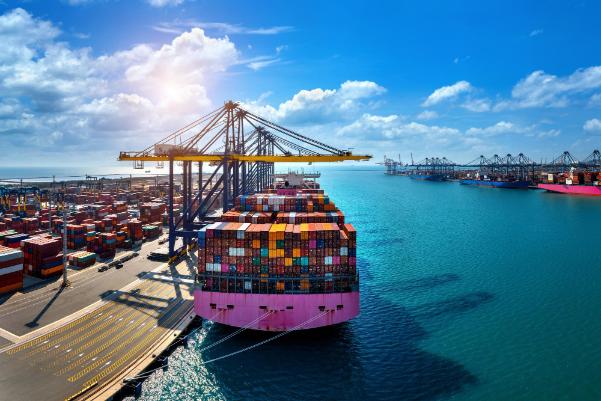
To be so cheap, the shipping giants do not stand alone, but must always shake hands with other “big guys” to form a strong system. Over the past time, China has witnessed many M&A and IPOs in the shipping and logistics industry.
One of the outstanding transactions of 2021 is the birth of China Logistics Group, with a charter capital of up to 4.7 billion USD, which is consolidated from 5 state-owned companies of the country. This includes: the former China Railway Supplies Corporation, China National Material Storage and Transport Depot, CTS International Logistics, China Logistics and National Packaging Company. China.
Currently, China Logistics Group owns 120 tracks, 42 warehouses, 4.95 million square meters of warehouse, and a fleet of three million vehicles worldwide.
Similarly, Alibaba’s logistics company Cainiao also holds a 15% stake in air cargo carrier Air China Cargo. Cainiao is also promoting long-term partnerships with LATAM Aviation and Atlas Aviation to leverage the power of air freight.
The ‘favors’ from the Chinese Government

The Chinese government also gives a lot of support to the shipping industry. A 2020 study by CSIS (‘Center for Strategic and International Studies’, or Center for Strategic and International Studies in the US) said that between 2010 and 2018, the Chinese government provided nearly $132 billion in aid. for the shipping and shipbuilding industry, not to mention other forms of support such as low-interest loans, raising barriers to foreign enterprises.
That is on a national scale. At the lower administrative levels, many districts and provinces in China also have many policies to subsidize transportation due to the strong growth potential of e-commerce.
For example, Ho Trung district (Hac Long Giang) in June 2022 announced the subsidy policy as follows: if the seller achieves at least 3000 e-commerce orders in a year, from the 3001th application, the district will support provide 1 yuan (about 3,500 VND) shipping fee for each order. Remember that within China, there are Taobao orders where the shipping price is only 2 yuan – 5 yuan (about 7,000 – 18,000 VND) is normal.
Subsidies from other Governments
Subsidies and subsidies from the domestic government are obvious. But the Chinese shipping industry also receives subsidies from the whole destination country!
On Amazon and eBay, Americans can buy watch batteries, necklaces, and electronic cables from China with shipping prices ranging from $0.70 to $0.99 (about 20,000 VND). Forbes commented: “With that price in the US, it’s not even possible to ship from here to across the street “.

A parcel sent in an ePacket from a Chinese seller to the US
In 2011, the United States Postal Service (USPS) signed a contract with China and Hong Kong postal shipping companies to allow shipping with tracking codes for parcels no larger than 36 inches and weighing no more than 2 kg to the US at extremely cheap prices, cheaper than domestic shipping within the US. This bundle of agreements is called ‘ePacket’. Shipping a half-pound parcel from Southern California to New York costs nearly $6, and from Beijing to New York only $3.66.
The same parcel, if sent back from New York to Beijing by USPS, it will cost 50 USD! This makes it nearly impossible for customers in the US to return items. Chinese e-commerce suddenly has a rather unfair advantage over rivals in the US.
Automated warehouse with smart robot
Warehouse management with automation and smart machines is one of the factors that makes China a leader in the transportation and logistics game. Currently, warehouses in China are applying one of two automatic sorting methods:
First, use an automatic sorting system by conveyor belt. A small parcel sorting system usually looks like this:
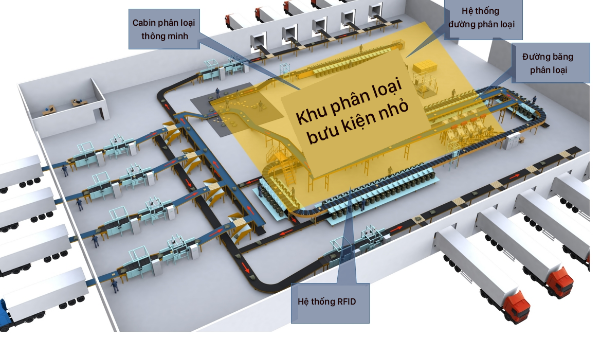

The runway and straight line sorting system scans the information on the bill of lading and pushes the parcel into the sorting compartment, reducing manpower by up to 70%.
Second, is the team of autonomous robots and sorting robots. In a Cainiao 1.8 square kilometer transit warehouse, 350 robots can process 21,000 parcels in an hour, reducing manual labor by up to 70%.
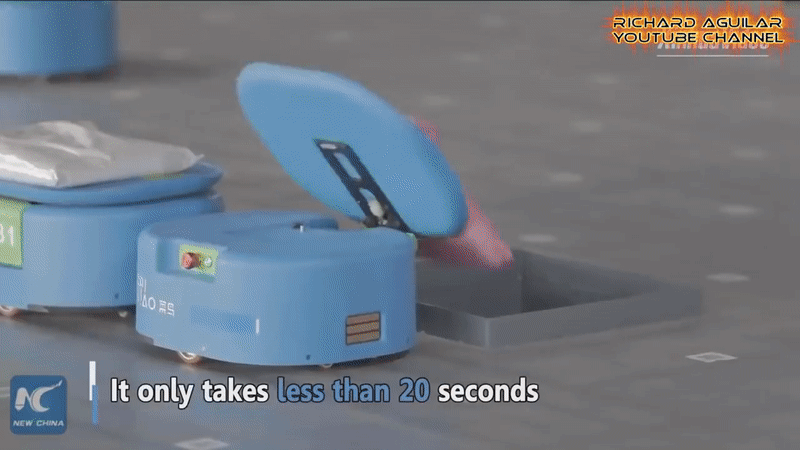
At Suning Retail Group’s Shanghai warehouse, autonomous robots (AGVs) can withstand loads of up to 800 kg when transporting packages, 10 times more efficiently than humans. When they run out of power, they know how to return to the charging station.
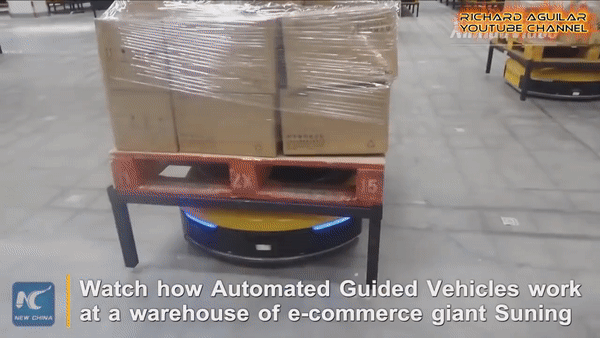
The automatic sorting center is a ‘secret weapon’ that helps Chinese e-commerce to cope with peak occasions such as November 11, Christmas, New Year, and so on.
Last mile shipping solution – an important bottleneck in B2C e-commerce.
Cainiao is a prime example when it comes to last mile transportation solutions.
The company’s strategy is to leverage and cooperate with a network of universities in China. The company set up 1,500 delivery stations on university campuses. Each station usually has an area of up to 1,000 square meters, including three zones: loading and unloading, receiving and sending parcels. At the same time, there are about 15 employees, 10 of which are students working part-time. That means Cainiao takes advantage of extremely cheap and readily available labor.
At a Cainiao delivery station at Jiangsu University, the station handles 5,000 orders a day. Thanks to these network of terminals, shipping to the final consumer becomes much easier and cheaper.

A Cainiao delivery station at the university
In the European market with Spain and France as examples, Cainiao also deployed more than 2,000 automatic lockers, operating 24/7. The recipient only needs to enter the code or scan the QR code to be able to open the receiving cabinet at any time in the industry quickly and economically. Problems such as the shipper not being able to contact the recipient or the recipient’s absence are completely eliminated.

Cainiao’s 24/7 locker in France
For the Vietnamese market, Chinese e-commerce players often shake hands with domestic logistics companies. In their eyes, Tiki is one of the most popular choices thanks to its extensive B2C logistics network.
By 2019, Tiki had 10 warehouse centers in Hanoi and Ho Chi Minh City. Ho Chi Minh City, Can Tho, Hai Phong, etc. and started targeting Chinese e-commerce players. Large companies will ship directly to Tiki warehouses in Vietnam. Smaller companies will deliver the goods to Tiki’s logistics cooperation facility in Shenzhen, China. Goods will be supported through customs clearance and then forwarded to Tiki’s warehouse in Vietnam. The remaining transportation for the last leg will be handled by Tiki.
Many other Vietnamese shipping companies are also cooperating with the Chinese side according to these models.
Low labor cost, high speed of development, fierce competition
In addition, there are other factors that everyone knows, such as: labor costs in China are very cheap, so a large number of workers can be hired. With the 996 working culture here, a shipper working 12 hours a day is normal.
China is also known for its highly developed highway system with a large capacity. At the same time, the e-commerce ‘cake’ is attracting many shipping companies to jump in at the same time, such as Cainiao, SF Express, ZTO, etc., causing relatively great competitive pressure.
References from: Mc Kinsey, Forbes, QQ News, Huzhong.gov.cn, Finance China
Source : Genk
